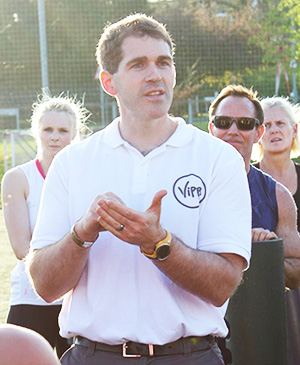
An interview with Michol Dalcourt
How did the idea for ViPR originate?
It goes back to my university days and the preconception I had of the human body. If anyone's view is that we are a series of different muscles that do different things, then you're going to train those muscles independently. That’s how we trained but, with the hockey players we coached, we saw there was a difference between the effectiveness of someone who lived in a rural area and an urban area regarding their movement.
What made them effective was they were able to work their entire body at one time so, for them, shoveling dirt and lifting bales of hay was a body-gain and body-training modality. It wasn’t just specific to the arms. All the science we were looking at was also pointing to the body being one unified thing so, with that broad concept in mind, we looked at how we trained and the equipment we were using.
What did you do after that?
We needed a tool that was heavy enough to challenge the appropriate tissues in certain ways. We started to flip this rubber mat that we rolled up and I thought that, if we put handles on it, then we could pick it up and it would have enough mass that we could weight it and un-weight it accordingly to elicit certain goals. So that’s exactly what I did. I had these prototypes made and we started to test them with elite professional hockey players. They came back and said, “The game slowed down for us.” Their ability to move had increased, as they had been training their whole body.
How did you go from the idea to the production?
It took us five years from our first prototype to getting it to market. Part of that process is putting together your patents and IP protection and the business structure, which all needs to be in place before distribution. The next part is getting the manufacturing to such a level where you can scale it: where you can make more of them but keep the same quality. Then you need to look at the education and application of it: what you can do with it. And then you have to trial the whole process.
Was the fitness industry resistant to the product or open?
Open; there were many educators and opinion leaders who blazed a trail for us and spoke about movement and functional training and they created a space for ViPR to live in and thrive. When we hit the market, the timing was perfect for us as there was a very receptive audience. Had it been that we came out as soon as we created ViPR, five years previously, it probably would have been more of a push to try and educate individuals but we took a lot of the good research and ideas and applied them right away.
What are your favorite moments on the ViPR journey?
There are a few that are etched on my memory but, in going through this process, you are so deep into it that you don’t step back and look at just what ViPR has meant to the industry and how quickly it has been adopted. Early on, when we had the prototypes made and the athletes came back very positively, that really was a point that gave me the conviction to push this one step further. It gave us the confidence to know that this – potentially – could be a game changer. And then, when we launched in the UK first with the help of FitPro, we very quickly were in most of the major chains in the UK. That early adoption was a suggestion that ViPR could be part of a bigger movement, part of the idea of looking at and moving the body as a whole thing.
What advice would you give to someone with an idea for a fitness product?
Be patient, as this is a process. Don’t think you have to do it so quickly before someone else does it before you – this is a fear I often hear but have rarely seen realized. People want to get their product out first but this normally means they don’t do their homework and research properly and either their education fails, their product can’t be delivered at scale or they haven’t created a space for the product. The next thing I would suggest is getting a working prototype and protecting that with IP, trademark and patent. After that you will have to monetize it somehow – either through a partnership, venture capital money or from friends and family.
This article originally appeared in the Oct/Nov 2012 issue of Fitpro magazine.
To view more ViPR content then click here to register – it’s absolutely free